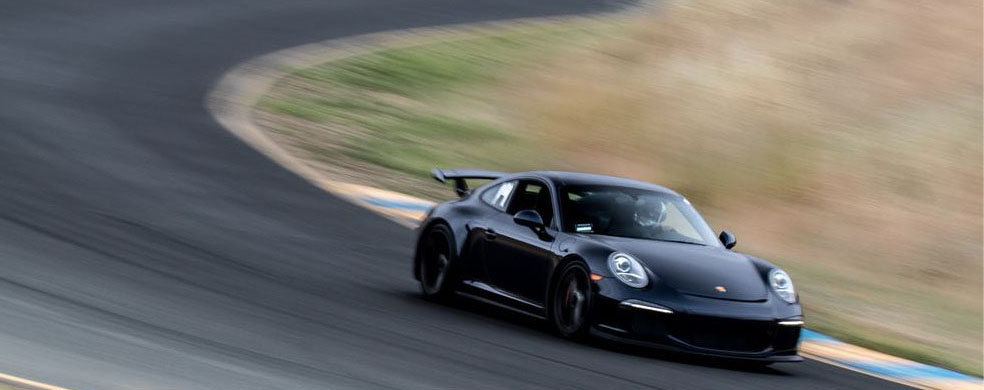
Justin's Moore's Mustang GT: Practicality Pays Dividends
After a long, challenging relationship with a peanut-eye STI, Justin Moore decided to get in a more reliable car and take advantage of the great lapping days available to him. This ‘11 Mustang GT needed some work to get it into the S3 title contender it is now, but it hasn’t given him any reason to stay out of the seat.
In its earliest state, Justin had wrapped the Mustang in highlighter yellow.
Justin Moore figured this time around, he’d save himself a little misery. Exchange some sentimental attachment for peace of mind, keep your ass in the seat, and drive the wheels off it. What is it? “It’s a piece of expendable athletic equipment,” he declares. That’s the way he feels about his 2011 Mustang GT. Not quite the passion project his big STI was, this Ford has proven to him that there are other aims in motorsport outside of manifesting the vehicle he saw in his teenage dreams.
The Mustang wasn’t the first dependable track vehicle he bought. Prior to this, he’d been autocrossing a 987.1 Cayman S with a few minor tweaks. Though the two got along beautifully, the thought of an IMS failure or a big crash in the Porsche left him feeling a little tense.
Rather than risk it, he sold the Porsche and consulted the knowledgeable Tony Rodriguez. “I wanted something that was fast, fairly cheap, fun, and fuss-free.” Basically, the costs had to be restricted to consumables for the platform to work. There were a few possibilities, but Tony and Justin agreed fairly quickly on the Mustang.
Most of the chassis modifications he’s chosen are second-hand, including the homemade splitter and the APR rear wing.
Soon enough, there was a new car in his driveway. With Tony’s guidance, the put together a fairly lengthy list of modifications: big wheels and tires, a few aero pieces, and a set of pads. The S3 rules at the time limited the tire width, but he learned to drive around the resulting understeer and got on with getting regular seat time.
Though the mechanical grip wasn’t really satisfactory, the combination of that and the aerodynamic download ended up ruining a motor. Oil starvation is never fun, but Justin didn’t sit with his head in his hands. Instead, he contacted Mark Luton and laid out a very basic plan for the replacement lump.
For Phase 2, Justin shed the yellow wrap.
Justin calls it “Stock Engine-Plus,” but that doesn’t really paint much of a picture. MMR made sure that the motor could handle track abuse and lateral loading. Included in the parts list is an expanded oil pan, an Accusump, and all the ARP hardware to make the motor more resilient. Of course, a few bolt-on modifications and a tune by Ed Susman helped raise the power output to a respectable 480 horsepower at the rear wheels. It’s also held up to all the abuse Justin’s put it through in the past two years.
After the motor came back, the rules changed. Now the SpeedSF Challenge rules allowed wider tires and the option of slicks without a big points hit, so Justin moved on from his 285-width Nankang AR1s to a set of Hoosier A7s measuring 315, and the handling balance shifted dramatically. “I used to deal with the understeer, which made me angry. Now, it’s neutral, forgiving, and much faster. Wider tires were exactly what this car needed.”
Getting the handling balance right also required leaning the front tires in some—about 3.6 degrees of negative camber. There’s not much one can do to improve the solid rear axle in that respect, so he dropped the rear as much as he could without scraping. Along with a Watts Link and a soft enough setup has given him enough grip and predictability to get airborne and continue attacking.
This handling balance and reliability allowed Justin to grow along with the car. “It was never scary—and not just on the track. There wasn’t a need to ever worry about much, and so I could relax and focus on the driving side of things.”
That approach paid off. Currently, Justin’s leading the S3 Championship and hoping to secure the title. All he’s had to do is build a motor—not a meager expense, but still a simple fix. Well, there were the modifications he had to make to his air-oil separator, but that’d have to be classified as a minor annoyance rather than anything that could turn hair gray. The rest has been sweet and simple.
Times
Thunderhill Cyclone: 1:57.465 (Speed SF record)
Thunderhill Bypass: 1:56.494
Thunderhill West: 1:20.610
Buttonwillow 13CW: 1:54.516
Laguna Seca: 1:36.938
Modifications
ST Suspension coilovers
Whiteline Watts link and front bar
Forgestar wheels 18x12”
Kooks long tube headers and x-pipe
C and J intake
custom air-oil separator
custom hood vents
Ford Performance crate motor with MMR-built bottom end.
ARP hardware
Ford Performance oil pump
Accusump
MMR baffled oil pan
Ford Performance trans cooler
3.55 final drive and rear end fluid expansion reservoir
lightweight radiator support subframe connector
APR GTC300 rear wing
Custom birch splitter
Boss 302 lower front fascia for brake ducts
Brembo Performance Package brakes
DBA brake rotors
Fidanza clutch assembly
steel braided clutch lines
Hawk DTC-60 brake pads
Holley dual fuel pump upgrade






